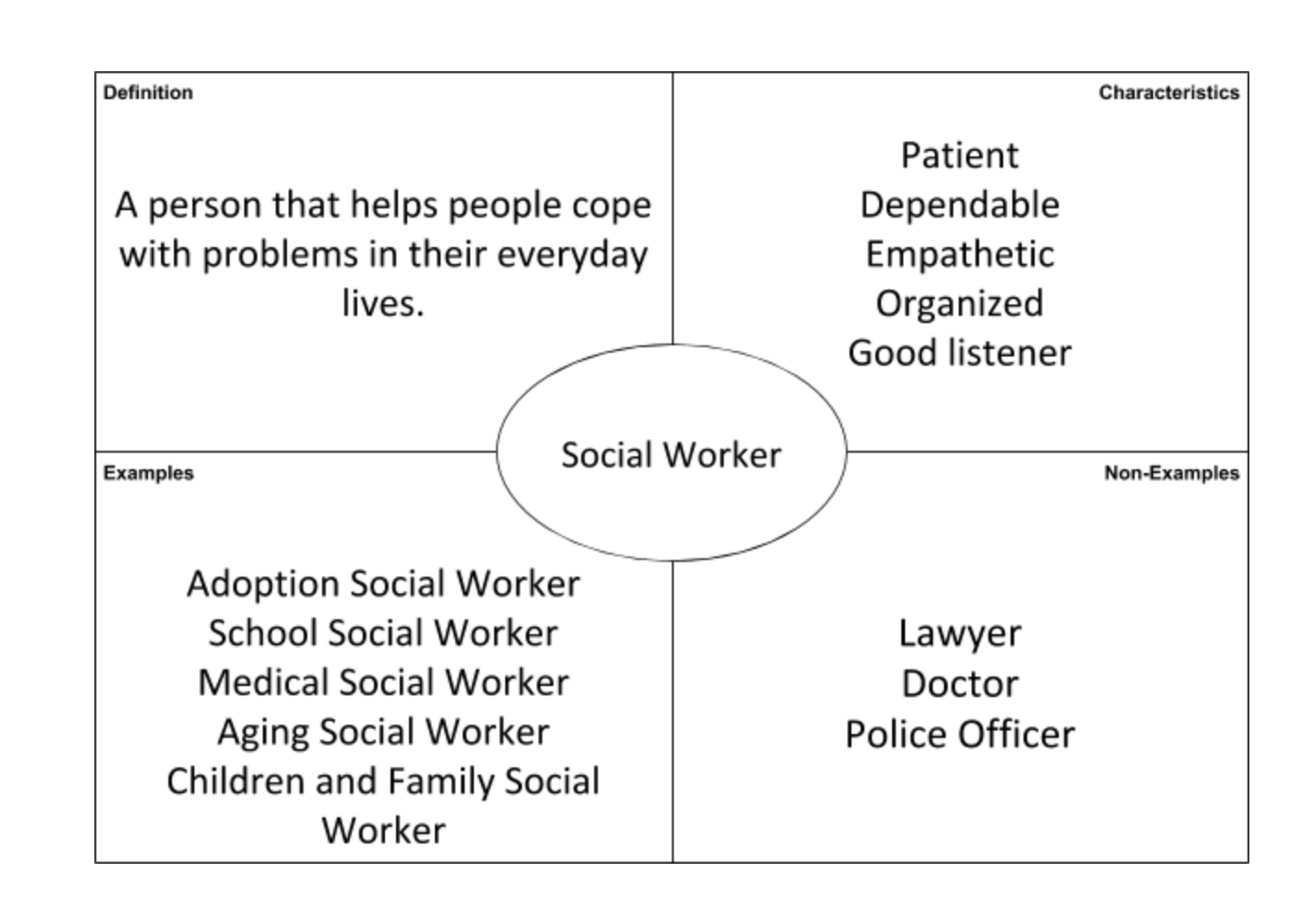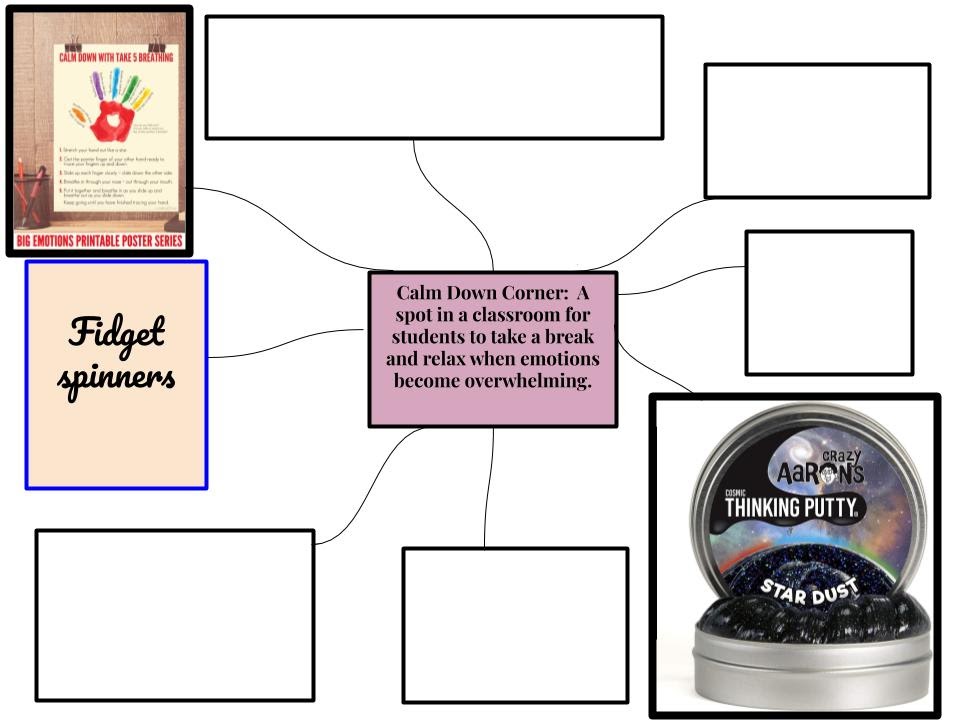Summary
Would you like to have a career that lets you help others and make a difference? Social workers have been doing this for more than 100 years, and it continues to be a much-needed job. In this activity, students read about the skills needed to be a social worker and the different career pathways available to social workers. Students complete an activity about the most difficult and most rewarding parts of social work. Then, students play the role of a school social worker by creating a Calm Down Corner. Finally, students watch an interview with a social worker in Oklahoma who currently works in the field as a therapist.
Overview
Would you like to have a career that lets you help others and make a difference? Social workers have been doing this for more than 100 years, and it continues to be a much-needed job. Currently, there are about 700,000 social workers in the United States. This career is expected to grow about 13% from 2019 to 2029, which is faster than the average rate of growth for careers. In 2019, the salary for social workers in the U.S. ranged from less than $31,800 to more than $82,500. According to OKCollegeStart, the average pay for social workers in Oklahoma is about $37,600.
Social work is a career located within the Human Services career cluster. People in this field work in a variety of places—from schools to government agencies, to clinics and hospitals. Social workers help people with various challenges they face. They can work specifically with children, teenagers, or adults. A social worker can choose to specialize, which means focusing on a particular area of work. However, a degree in social work does not limit you to only one career path. Lots of different jobs are available to someone with a social work degree, and many people gain experience in several areas of social work throughout their careers.

If you choose to go into social work, it is important to have certain skills and abilities. Wanting to help people who are going through stressful or difficult situations, and empathizing with them during these times, are key skills you will need to have. Organization is important, too, because social workers must keep detailed records of interactions with the people or families they work with. Another necessary skill for social work is the ability to clearly communicate and listen to people without judgment. A social worker is looked to during times of crisis as a helper and someone who can provide a sense of calm.
School Social Worker
A school social worker helps students with many issues. They help students deal with academic difficulties or issues at home, and they are someone students can talk to about their problems. School social workers often work with families to provide needed resources such as food, clothing, and other items by connecting families with people in the community who can help.
Aging Social Worker
An aging social worker is also known as a geriatric social worker. This focus of work helps people who are older and need more assistance. Geriatric social workers connect elderly people with services in the community that provide food and medical resources. They help older people maintain an independent lifestyle for as long as possible.
Medical Social Worker
A medical social worker works with patients in a hospital. They provide support and resources for people recovering from surgery or sickness. Medical social workers check in with patients and patients’ families to ask if they have any questions and to make sure the patient is feeling comfortable. Sometimes, they help patients get the services needed to go home after a hospital stay. Some of these services include transportation to get home, meal plans, and in-home medical equipment. It is important to feel comfortable working with sick people and dealing with stressful and emotional situations if you want to go into this area of social work.
Adoption Social Worker
An adoption social worker works to help children who may need a new home. Sometimes, parents are unable to provide shelter, food, and safety for their children, so an adoption social worker places the children with a new family. They match children with families that want to adopt a child. Adoption social workers can work for the government or for nonprofit organizations. A nonprofit organization is a group of people that provides help to communities without charging any money to the people they help. An adoption social worker could work in many different locations depending on the day—they could be in a school, an adoptive family’s home, or a hospital. They need to be a good listener and feel comfortable working with kids. It also is necessary to have good judgment when placing children in adoptive homes.
All types of social workers need to have these key skills and abilities:
Listens carefully and patiently.
Empathizes with and cares for others.
Is comfortable with speaking to people about difficult situations.
Can work in stressful situations and manage stress.

Materials List
Internet access
Google Drawings (or another online tool for diagramming)
Copy paper and colored pencils (optional)
Superheroes in Disguise Student Guide (attached)
T-Chart activity (found on page 7 of the Student Guide)
Mind Map activity (found on page 8 of the Student Guide)
Gist template (found on page 9 of the Student Guide)
What to Do
Note that you can use the attached Superheroes in Disguise Student Guide for the activities on this page. The Student Guide can be viewed on your computer or printed out.
Start with Activity 1: T-Chart. Read the article linked below to learn what social workers say about their career. Then, complete the T-chart by writing in what you think are the most difficult parts and the most rewarding parts of being a social worker.
Move to Activity 2: Mind Map. Imagine you are a school social worker and have been asked to create a “Calm Down Corner” in a classroom for students who feel overwhelmed or upset. Brainstorm what types of items you would put in the Calm Down Corner. After you have thought of some items, create a mind map using your ideas. Add words and images to your mind map.
Move to Activity 3: Interview with a Social Worker. Watch a video of an interview with a licensed social worker in Oklahoma. The social worker currently works with children and families as a therapist. After viewing the video, respond to a prompt by creating a Gist statement.
Activity 1: T-Chart
Read the article “Social Worker: Interviews,” which features interviews with two people who are social workers.
Complete a T-chart (either by printing T-chart on page 7 of the attached Student Guide or by creating your own like the one below) by writing in what you think would be the most difficult parts of being a social worker and the most rewarding parts of being a social worker.
Activity 2: Mind Map
Imagine you are a social worker who is employed by an elementary school. You have been given the task of creating a space for students to calm down when they are having a difficult time in class. In your own table (either the one on page 8 of the attached Student Guide or one of your own creation the one below), brainstorm a list of things you would include in a classroom’s Calm Down Corner:
After you fill out the table, create a mind map to illustrate your ideas for a Calm Down Corner using text descriptions and images. A mind map helps you to organize information in a visually appealing way. To create your mind map, you can use Google Drawings or another online tool for creating diagrams, or you can use copy paper and colored pencils. Pictured below is an example of how to format a mind map.

Activity 3: Interview with a Social Worker
Watch the following interview with a social worker who works in Oklahoma and attended college in Oklahoma: Social Worker Jessica Schonlau—Zoom into Your Career.
After watching, respond to one of the prompts below with the Gist strategy. Using the Gist template on page 9 of the Student Guide or with a pen and paper, create your own summary limited to 28 words or fewer.
What is a typical day like for a social worker?
What education is needed to be a social worker?
Why would someone want to be a social worker?
Resources
Anne and Henry Zarrow School of Social Work. (n.d.). Flyer [Image]. OU College of Arts and Sciences. https://www.ou.edu/content/dam/cas/socialwork/docs/swk_100_jobs.pdf
Bureau of Labor Statistics. (2020, September 16). Occupational Outlook Handbook: Social Workers. U.S. Department of Labor. https://www.bls.gov/ooh/community-and-social-service/social-workers.htm
Health Care Social Worker Drawing [Image]. (n.d.). Pixy. https://pixy.org/764068/
K20 Center. (n.d.). Gist. Strategies. https://learn.k20center.ou.edu/strategy/3289
K20 Center. (2021, January 2021). Social Worker – Jessica Schonlau – Zoom Into Your Career. YouTube. https://youtu.be/iD9roYUbBGw
Lueders, B. (2019, January 15). 10 Frequently Asked Questions for Geriatric Social Workers. Right at Home. https://www.rightathome.net/blog/geriatric-social-workers-faqs
Okcollegestart. (n.d.). Interviews. Human Services: Social Worker. https://secure.okcollegestart.org/Career_Planning/Career_Profile/Career_Profile.aspx?id=T1lqy3iYKc6BrBhgDvayPwXAP3DPAXXAP3DPAX&screen=9
Piatt, E. (n.d.). How to Create a Calm Down Corner in 5 Easy Steps. Creatively Teaching First. https://www.creativelyteachingfirst.com/blog/calm-down-corner-in-classroom
School Social Work Association of America. (n.d.). Role of School Social Worker. SSWAA. https://www.sswaa.org/school-social-work
Social Work Degree Guide. (n.d.). 5 Important Characteristics of a Social Worker. Red Ventures. https://www.socialworkdegreeguide.com/lists/5-important-characteristics-of-a-social-worker/
Social Work Degree Guide. (n.d.). What Do Medical Social Workers Do? Red Ventures. https://www.socialworkdegreeguide.com/faq/what-do-medical-social-workers-do/
Social Work Degree Guide. (n.d.). What Does an Adoption Social Worker Do? Red Ventures. https://www.socialworkdegreeguide.com/faq/what-does-an-adoption-social-worker-do/
Staake, J. (2020, June 9). How to Create and Use a Calm-Down Corner in Any Learning Environment. WeAreTeachers. https://www.weareteachers.com/calm-down-corner/


